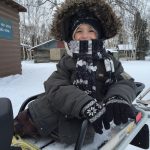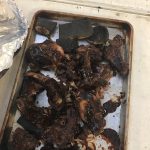If you lived without restaurants, supermarkets, and shopping centers would you feel lacking, or could your senses awaken and be nourished by the subtleties of life around you? Might you find richness in the details of the forest or perceive treasure in a beaver pond? How do we determine the value of that which exists outside the marketplace, particularly if we don’t truly understand it––are these things really lacking if the landscape provides?
As electronic devices mute our relationship with the natural world, debates resound about the value of what’s being lost. Connection to a landscape, awareness of ecosystems larger than ourselves, even human connection are jeopardized in our fast-paced society.
In a way, the Iditarod connects the Western world to a piece of its heritage. Dog teams tie together a vast landscape without the use of combustible engines and gives outsiders a lens to appreciate country that most of us will never visit. We become armchair explorers cheering on the brave and determined. Yet perhaps it is not so much the distance that makes this race so special, as it is the landscape’s intricacies along the way.
Richard Nelson wrote in Make Prayers to the Raven, “Anyone who travels in or over the boreal forest quickly recognizes that it is made up of many different natural communities––a sprawling puzzle of forest, muskeg, thicket, wetland, and waterway. But this is just the visible complexity, for there is another level beyond it, one known only to those who derive their livelihood directly from the wildland. Only through lifetimes of use and dependency is the hidden labyrinth of the northern forest revealed.”
Nelson was writing about the Koyukon people of Huslia. He lived in Huslia in a time when dogs were a way of life. The advent of the snow machine (snowmobile) replaced the necessity for dogs and urged in a new era for Koyukon people, yet it is not the first lifestyle evolution for this indigenous culture.
“A long time ago people used to stay in camps in different seasons,” Fred Bifelt of Huslia explains. “They moved to fish camp, trapping, beaver ponds, whatever. There’s no way you can stay in one community like this because you go eat the area out and start starving you know? But you had to move around migrating and all that. But when times started changing and we started having public education, they required us to have our kids go to school, that’s why we started having towns like this.” But in the era of dog teams, there was perhaps no finer dogs than in Huslia.
“That’s how we were raised,” Fred says. “That’s how our people made a living a long time ago. We don’t do that anymore but it’s still with of us, you know.” Fred’s father Cue Bifelt is a late former champion of both the Fur Rendezvous and the Open North American sprint dog races. An excerpt from his obituary reads, “At the passing of his mother at a young age, he rarely left his father’s side. Because of this he learned lifelong lessons about respecting the land, animals and waterways – this he passed on to his family.” Stewardship of the land is still the cultural pillar that ties generations together in Huslia. “We have a lot of respect for nature,” Fred explains. “Nature feeds us, takes care of us, so we can’t treat it wrong, that’s what we’re taught, you know?” The survival of the people has always depended on it. It is a bond he likens to that of a farmer or rancher
“This is kind of a hard place to make a living,” he continues. “In this particular geography [there’s] not really a lot of fish or a lot of caribou.” Huslia doesn’t sit on the Yukon river whose salmon runs are the life force of villages like Tanana and Kaltag. Thus the people of Huslia must tune in to nature’s nuances in order to thrive. “That’s the way we’re raised. It’s funny, I remember when we were kids my mom used to tell us, ‘don’t talk with your mouth.’ We’re taught to let your actions speak for itself. We don’t have to boast. Stuff like that, you know? Be quiet and be observant and listen. So it goes way back; it’s part of survival.”
Fred recalls when John Baker of Kotzebue keyed into that challenge in this village on the Koyukuk river in the 2015 Iditarod and contrasted it with the ocean’s abundance. Fred concludes, “Way back in the day that’s why dogs were so important. That was our survival. And if you didn’t have good dogs you were in jeopardy.”
“Everyone had good dogs,” Fred recalls. “Man, they’d drive the dog machines just like you’re driving a truck or a snow machine or whatever. You would see dog teams going back just all day long hauling wood. They’d just park their dogs here, walk in the house, and later they’d come out, jump on, and take off. That’s the way it was before snow machines came.” Fred believes that’s why so many champions came from this region, because their abilities were groomed from dependency on a vast, subtle landscape.
But it was hard to feed so many dogs in an era before kibble. The snow machine phased out the working sled dog and they sold them to names like Redington and Mackey. “If we had those dogs, they would be here right now. They’d be out front, that’s how good they were,” Fred states.
The names of Huslia champions are well known in the mushing community, and mushers with dogs from those bloodlines have expressed unabashed honor to travel this country with their dogs. In 2015, just after the passing of Huslia native and mushing icon George Attla, many mushers echoed the same sentiment to Insider: the dogs are going home.
School let out early in Huslia today, and there hasn’t been a moment since when the dog yard wasn’t bustling with children. In turn, mushers have welcomed kids’ questions and invited them to enjoy their fastidious interest.
Warner Vent, a revered village elder who took second in the first Iditarod and has countless awards from other races, hopes it will encourage some of them to take up the sport. The community hopes this race will further solidify the cultural foundation they’ve shared with their children as the next generation carves its place in the world. This is one of the only Native villages whose population is growing, in an era
when many rural Alaskans are migrating to the road system. And for those who do seek a life outside, CeCe Nollner hopes this might show them they could have a career as cameraman or writer, and bring those skills home should the Iditarod come to Huslia again. “This is a motivation for them.”
Huslia has welcomed Iditarod mushers, staff, and volunteers with unmatched warmth. There is no lacking; for two days already, the women have cooked delicious meals and kept the community hall filled with local favorites like moose ribs and beaver meat. In fact, this race wouldn’t be possible without their generosity.
“The late Catherine Attla used to say all the time, ‘we live so far out of the way, it’s not like the Yukon with close villages. When people come here we just go all out for helping them out––feeding them and taking care of them,’” Fred’s friend Joe explains. “That’s how it is now. It’s just a little bigger thing now with the Iditarod, but we’re doing it.”
Fred agrees, “We’re honored to have [the Iditarod] come here and it really makes us feel good. You know, that’s how we were raised, that’s how our people made a living a long time ago. We don’t do that anymore but it’s still with of us, you know. It’s always in our heart.”








































